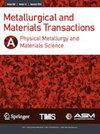高温拉伸试验在用s形曲线模型表示最小蠕变速率中的重要作用
IF 2.2
3区 材料科学
Q3 MATERIALS SCIENCE, MULTIDISCIPLINARY
Metallurgical and Materials Transactions A-Physical Metallurgy and Materials Science
Pub Date : 2023-09-25
DOI:10.1007/s11661-023-07202-w
引用次数: 0
摘要
摘要对电厂和航空发动机用材料的蠕变寿命进行表征具有重要意义。本文说明了材料的抗拉强度在精确的蠕变性能表征中所起的重要作用。它还表明,公布的高温抗拉强度值并不总是适用于某些蠕变模型,因为它的应变速率依赖。为了解决没有合适的抗拉强度数据的问题,本文直接从最小蠕变率数据中估计这些值。当将该技术应用于用s形曲线表示最小蠕变速率与归一化(相对于抗拉强度)应力之间关系的模型时,可以观察到对2.25Cr-1Mo钢数据拟合的改善。研究结果表明,未来有必要研究高温拉伸试验中使用的最合适的应变速率,以便将所得的拉伸强度值用于蠕变建模。本文章由计算机程序翻译,如有差异,请以英文原文为准。
The Important Role Played by High-Temperature Tensile Testing in the Representation of Minimum Creep Rates Using S-Shaped Curve Models
Abstract It is important to characterize the creep life of materials used in power plants and aeroengines. This paper illustrates the important role played by a material’s tensile strength in enabling accurate creep property representations to be made. It also shows that published high-temperature tensile strength values are not always suitable for use in certain creep models due to its strain rate dependency. To deal with the absence of such suitable date on tensile strength, this paper estimates such values directly from minimum creep rate data. When this technique is applied to models that represent the relationship between minimum creep rates and normalized (with respect to tensile strength) stress using S-shaped curves, an improvement in the fit to data on 2.25Cr–1Mo steel was observed. The findings suggest an important need for future research into the most appropriate strain rates to be used in high-temperature tensile testing when the purpose is to use the resulting tensile strength values for use in creep modeling.
求助全文
通过发布文献求助,成功后即可免费获取论文全文。
去求助
来源期刊
CiteScore
5.30
自引率
7.10%
发文量
322
审稿时长
6 months
期刊介绍:
Metallurgical and Materials Transactions A focuses on the latest research in all aspects of physical metallurgy and materials science. It explores relationships among processing, structure, and properties of materials; publishes critically reviewed, original research of archival significance.
The journal address the main topics of alloy phases; transformations; transport phenomena; mechanical behavior; physical chemistry; environment; welding & joining; surface treatment; electronic, magnetic & optical material; solidification; materials processing; composite materials; biomaterials; and light metals. MMTA publishes Technical Publications, Communications, Symposia, and more.
Published with ASM International, The Materials Information Society and The Minerals, Metals & Materials Society (TMS)

 求助内容:
求助内容: 应助结果提醒方式:
应助结果提醒方式:


